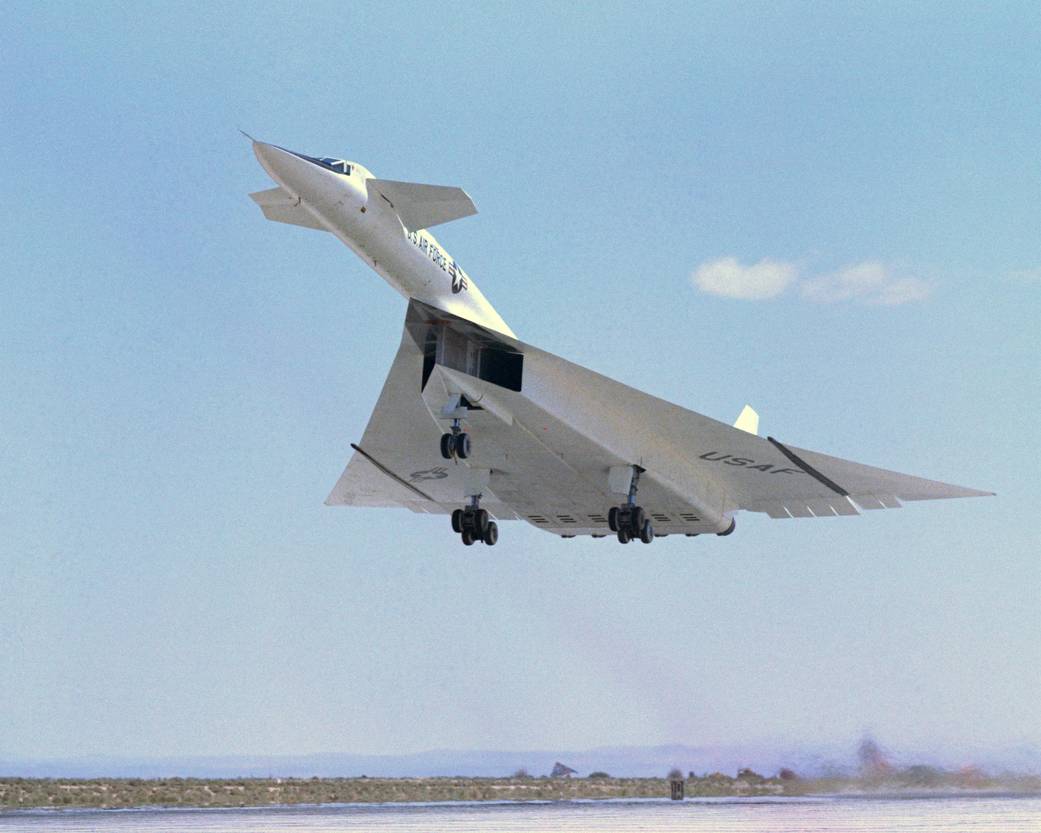The B-70 Valkyrie, with a planned cruise speed of Mach 3 and operating altitude of 70,000 feet, was to be the ultimate high-altitude, high-speed manned strategic bomber. Events, however, would cause it to play a far different role in the history of aviation.
To achieve Mach 3 performance, the B-70 was designed to “ride” its own shock wave, much as a surfer rides an ocean wave. The resulting shape used a delta wing on a slab-sided fuselage that contained the six jet engines that powered the aircraft. The outer wing panels were hinged. During take off, landing, and subsonic flight, they remained in the horizontal position. This feature increased the amount of lift produced, improving the lift-to-drag ratio. Once the aircraft was supersonic, the wing panels would be hinged downward. Changing the position of the wing panels reduced the drag caused by the wingtips interacted with the inlet shock wave. The repositioned wingtips also reduced the area behind the airplane’s center of gravity, which reduced trim drag. The downturned outer panels also provided more vertical surface to improve directional stability at high Mach numbers. Attached to the delta was a long, thin forward fuselage. Behind the cockpit were two large canards, which acted as control surfaces.
As impressive a technological feat as the B-70 represented, the aircraft was under development at a time when the future of the manned bomber was uncertain. During the late 1950s and early 1960s, many believed that manned aircraft were obsolete, and the future belonged to missiles. As a result, the Kennedy Administration ended plans to deploy the B-70. Two experimental XB-70A prototypes were under construction at North American Aviation when the program was canceled.
The XB-70 Valkyrie seemed to be a perfect testbed for SST research. It was the same size as the projected SST designs, and used similar structural materials, such as brazed stainless steel honeycomb and titanium. Thus, the XB-70A’s role changed from a manned bomber prototype to one of the most remarkable research aircraft ever flown.
The XB-70A number 1 (62-001) made its first flight from Palmdale to Edwards Air Force Base, CA, on Sept. 21, 1964. Tests of the XB-70’s airworthiness occurred throughout 1964 and 1965 by North American and Air Force test pilots. The Flight Research Center prepared its instrument package. Although intended to cruise at Mach 3, the first XB-70 was found to have poor directional stability above Mach 2.5, and only made a single flight above Mach 3. Despite the problems, the early flights provided data on a number of issues facing SST designers. These included aircraft noise, operational problems, control system design, comparison of wind tunnel predictions with actual flight data, and high-altitude, clear-air turbulence.
NASA Ames Research Center, Moffett Field, CA, wind-tunnel studies led engineers at North American Aviation in Downey, CA, to build the second XB-70A (62-207) with an added 5 degrees of dihedral on the wings. This aircraft made its first flight on July 17, 1965. The changes resulted in much better handling, and the second XB-70 achieved Mach 3 for the first time on Jan. 3, 1966. The aircraft made a total of nine Mach 3 flights by June…Learn more
XB-70A number 1 was transferred to the National Museum of the United States Air Force in Dayton, Ohio on February 4, 1969.



























